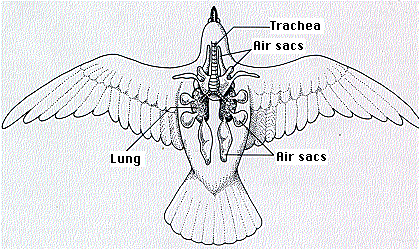| Index to this page |
 The frog's lungs are a pair of thin-walled sacs connected to the mouth through an opening, the glottis. The surface area of the lungs is increased by inner partitions which are richly supplied with blood vessels.
The frog inflates its lungs by
The frog's lungs are a pair of thin-walled sacs connected to the mouth through an opening, the glottis. The surface area of the lungs is increased by inner partitions which are richly supplied with blood vessels.
The frog inflates its lungs by
The frog's circulatory system, which brings oxygen-depleted blood to its lungs (and skin) and takes oxygen-enriched blood away is described in a separate page. Link to it.

The skin of reptiles is dry and scaly, so they can live in arid locations (although many do not). However, they cannot use their skin as an organ of gas exchange. Reptiles depend entirely on their lungs for this.
Their lungs are considerably more efficient than those of amphibians.While fresh air flows in and stale air out of the lizard's lungs, another reptile, the American alligator, uses a more efficient mechanism similar to that described below in birds.)
The lizard's circulatory system, which brings oxygen-depleted blood to its lungs and takes oxygen-enriched blood away is described in a separate page. Link to it.

Unlike reptiles, birds are homeothermic ("warm blooded"), maintaining a constant body temperature (usually around 40°C) despite wide fluctuations in the temperature of their surroundings. They maintain their body temperature with the heat produced by muscular activity. This depends, in turn, on a high rate of cellular respiration. So the demands on the gas-exchange efficiency of the lungs of a small, active bird are great.
Although the ventilation of bird lungs is similar to that of reptiles, their effectiveness is increased by the presence of air sacs. Although no gas exchange occurs in the air sacs, their arrangement increases the efficiency of lung ventilation by enabling fresh air to pass in one direction through the lungs during both inhalation and exhalation.
The air sacs also aid in reducing the density of the body by substituting air for tissue or fluid in many places. Even some of the bird's bones are penetrated by air sacs.
The anatomy and physiology of mammalian lungs is described (using humans as the example) in a separate page. Link to The Human Respiratory System.
| Welcome&Next Search |